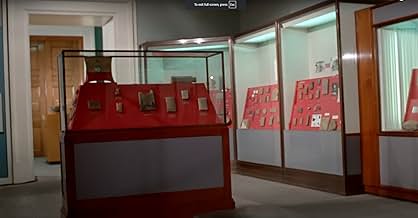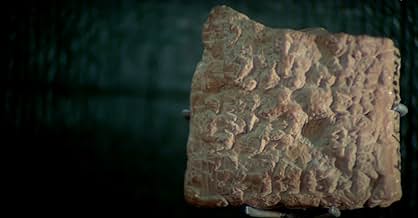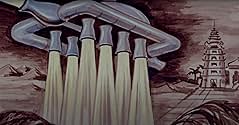CALIFICACIÓN DE IMDb
6.2/10
1.8 k
TU CALIFICACIÓN
Agrega una trama en tu idiomaBased on Erich Von Daniken's book purporting to prove that throughout history aliens have visited earth.Based on Erich Von Daniken's book purporting to prove that throughout history aliens have visited earth.Based on Erich Von Daniken's book purporting to prove that throughout history aliens have visited earth.
- Dirección
- Guionistas
- Elenco
- Nominado a 1 premio Óscar
- 1 nominación en total
- Dirección
- Guionistas
- Todo el elenco y el equipo
- Producción, taquilla y más en IMDbPro
Opiniones destacadas
This lively production loosely based on von Daniken's first work, 'Chariots of the Gods?' brought his theories of alien visitations in the past to the attention of the movie going audience. At that time it was a break-through in thinking. Since then von Daniken has presented dozens of more books of proofs, many of them more scientific and hard-nosed than this. As a result, there have been bookshelves full of other books on this subject, including those written by scientists, professors and other notable experts. Meanwhile, a campaign of debunking this whole theory is maintained by a clique of limited thinkers, believing in their arrogance, that this is the only world in the entire universe on which intelligent life arose - gimme a break! Watch it again for the joy of discovery. A tremendous soundtrack is a bonus
Let me start off by saying that I love movies and documentaries about the paranormal, strange phenomena and unexplained mysteries. I particular enjoyed the old Rod Serling specials produced by Alan and Sally Landsburg, but I always regretted not having seen Chariots of the Gods.
I didn't miss anything.
On the face of it, this film would make a lovely travelogue of Mexico and South America because, despite the premise of exploring and/or revealing ancient mysteries, it actually does very little of either.
True, all the old familiar sites are visited, but the bland narration does little more than tell you that these places are associated with mysterious doings. It would be like a documentary on ghosts and hauntings showing only the exterior of the Amityville house and saying vaguely "...and the Lutz family claimed to have experienced something here, in this house."
The photography is very nice, the camera angles fresh and dramatic, but as I mentioned earlier, the narration (both the text itself and the narrators) is monotonously bland and surprisingly UN-informative; which negates any instructional value the film might have had as a documentary. Again, just change the narration and this could be a fine travelogue.
I suspect that the high ratings people give this title are based merely on that -the title and its association with the excellent and influential book- and less on the film itself. I also suspect that people are remembering the soundtrack LP (and later CDs) of the excellent Peter Thomas score -which ironically is almost unrecognizable in the garbled monaural sound mix of the film itself.
My opinion is that you should ignore this film and look instead at the much more dramatic and informative In Search of Ancient Astronauts (which is itself a far superior re-edit of this film, narrated by Rod Serling), or any of the other Landsburg productions, like In Search of Ancient Mysteries, The Outer Space Connection or Encounter With The Unknown.
For that matter, track down the old In Search Of... TV programs or Robert Stack ferreting out those Unsolved Mysteries.
I didn't miss anything.
On the face of it, this film would make a lovely travelogue of Mexico and South America because, despite the premise of exploring and/or revealing ancient mysteries, it actually does very little of either.
True, all the old familiar sites are visited, but the bland narration does little more than tell you that these places are associated with mysterious doings. It would be like a documentary on ghosts and hauntings showing only the exterior of the Amityville house and saying vaguely "...and the Lutz family claimed to have experienced something here, in this house."
The photography is very nice, the camera angles fresh and dramatic, but as I mentioned earlier, the narration (both the text itself and the narrators) is monotonously bland and surprisingly UN-informative; which negates any instructional value the film might have had as a documentary. Again, just change the narration and this could be a fine travelogue.
I suspect that the high ratings people give this title are based merely on that -the title and its association with the excellent and influential book- and less on the film itself. I also suspect that people are remembering the soundtrack LP (and later CDs) of the excellent Peter Thomas score -which ironically is almost unrecognizable in the garbled monaural sound mix of the film itself.
My opinion is that you should ignore this film and look instead at the much more dramatic and informative In Search of Ancient Astronauts (which is itself a far superior re-edit of this film, narrated by Rod Serling), or any of the other Landsburg productions, like In Search of Ancient Mysteries, The Outer Space Connection or Encounter With The Unknown.
For that matter, track down the old In Search Of... TV programs or Robert Stack ferreting out those Unsolved Mysteries.
I was 11 years old in 1973 when I read some of "Chariots of the Gods?" and saw "In Search of Ancient Astronauts," a condensed version of this 1972 documentary. As a kid, you are impressible and can be enthralled by these new ideas, that maybe aliens helped humankind along the way to advanced civilization.
As an adult seeing "Chariots of the Gods" 35 years later, I was amazed at the claims the narrator sometimes makes, leaving out significant background details and being excessively one sided. There are several specific examples. In the first, a visit is made to the Iraq Museum in Baghdad, where a set of curved tubes is said to be the exhaust port on the bottom of the rocket (and the base of a Saturn one is shown for comparison). However, no details are given of where the artifact was found, how old it was or what mainstream archaeologists thought it was.
In the second, there were statues in Mexico, who were claimed to be wearing odd hats, communication or utility devices on their chests and perhaps weapons or communicators on their belts. No alternative opinion was presented, such as the "communicators" might just be ordinary breastplates, and the hats some kind of ornamental warrior headgear. Additionally in Pelenque, Mexico, a sarcophagus lid for the Mayan leader Pacal is supposed to be a rocket ship, with no additional explanation given that his "rocket" might actually be a collection of Mayan symbols representing the king's passage to the underworld, and the meaning of these symbols unknown to few modern people except archaeologists specializing in pre-Columbian history.
I liked the crazy, spacey soundtrack, which ranged from early '70s electronica to New Ageish acoustic, and the cinematography, much shot from the skies -- the way these alleged "ancient astronauts" might have seen the earth! There just wasn't enough evidence presented that aliens created all these mysteries, which certainly are unexplainable.
Spacemen? I don't know. The theory that humans, not aliens, reached a high level of civilization thousands of years ago -- say more like late 21st century -- only to have it destroyed by a natural disaster, such as an ice age, seems like a more probable explanation for the supposedly advanced technologies in ancient artifacts and even the strange costumes. People knocked back to the stone age by a disaster over generations could have forgotten their heritage, old costuming and technology and have only traces, which to them might become religious legends. They might record them on cave or cliff walls in images that look more familiar to us because we are advanced, just like their distant ancestors. And artifacts that were fabricated with technology similar to ours thousands of years ago also could have come from these very ancient humans, not a bunch of extraterrestrials!
As an adult seeing "Chariots of the Gods" 35 years later, I was amazed at the claims the narrator sometimes makes, leaving out significant background details and being excessively one sided. There are several specific examples. In the first, a visit is made to the Iraq Museum in Baghdad, where a set of curved tubes is said to be the exhaust port on the bottom of the rocket (and the base of a Saturn one is shown for comparison). However, no details are given of where the artifact was found, how old it was or what mainstream archaeologists thought it was.
In the second, there were statues in Mexico, who were claimed to be wearing odd hats, communication or utility devices on their chests and perhaps weapons or communicators on their belts. No alternative opinion was presented, such as the "communicators" might just be ordinary breastplates, and the hats some kind of ornamental warrior headgear. Additionally in Pelenque, Mexico, a sarcophagus lid for the Mayan leader Pacal is supposed to be a rocket ship, with no additional explanation given that his "rocket" might actually be a collection of Mayan symbols representing the king's passage to the underworld, and the meaning of these symbols unknown to few modern people except archaeologists specializing in pre-Columbian history.
I liked the crazy, spacey soundtrack, which ranged from early '70s electronica to New Ageish acoustic, and the cinematography, much shot from the skies -- the way these alleged "ancient astronauts" might have seen the earth! There just wasn't enough evidence presented that aliens created all these mysteries, which certainly are unexplainable.
Spacemen? I don't know. The theory that humans, not aliens, reached a high level of civilization thousands of years ago -- say more like late 21st century -- only to have it destroyed by a natural disaster, such as an ice age, seems like a more probable explanation for the supposedly advanced technologies in ancient artifacts and even the strange costumes. People knocked back to the stone age by a disaster over generations could have forgotten their heritage, old costuming and technology and have only traces, which to them might become religious legends. They might record them on cave or cliff walls in images that look more familiar to us because we are advanced, just like their distant ancestors. And artifacts that were fabricated with technology similar to ours thousands of years ago also could have come from these very ancient humans, not a bunch of extraterrestrials!
In the beginning there was the book "Intelligent Life in the Universe," whose co-authors (Iosif Shklovsky and Carl Sagan) cautiously postulated that the ancient Babylonian legend of Oannes might represent an instance of paleocontact. There were also the Tassili frescoes, whose nominal discoverer (Henri Lhote) believed that they depicted extraterrestrial beings. And that was pretty much it.
Then, in 1967, came Erich von Däniken. Millions read his book "Chariots of the Gods?" and millions more saw this documentary film that was based on it. The viewer was presented with beautifully-shot footage of various archaeological ruins around the world (accompanied by Peter Thomas's shimmering, irresistible soundtrack), and the belief that "aliens built the Pyramids" became cemented in the popular consciousness. So, too, did the patently ridiculous notion that the Nazca lines of Peru were landing strips for alien aircraft. Von Däniken later conceded that he had simply made this up.
And that's the problem: he was happy to make things up if it sold books. Shklovsky and Sagan had emphasized very specific criteria in the interpretation of ancient legends as reports of contact between earthlings and intelligent extraterrestrial lifeforms, hence their careful choice of a single legend which *might* represent such contact. In von Däniken's view, any legend or pile of ruins was fair game; if it was old, then it was attributable to aliens. It goes without saying that this total indifference to accuracy has done enormous damage to the field of Paleo-SETI.
(Incidentally, von Däniken's critics have been just as indifferent in their dismissal of the Paleo-SETI theory's particulars, and two wrongs don't make a right. Yes, von Däniken is a clown, but that doesn't explain away the Piri Reis maps, whose mysteries were documented well before the ancient astronauts craze in Charles Hapgood's "Maps of the Ancient Sea Kings." And yes, *some* of the Tassili frescoes were faked, but the two featured prominently in this film--the horned faceless figure and the so-called Great God Mars--evidently are not among the fabrications. This can be confirmed via a Google search, but of course most people won't bother.)
Then, in 1967, came Erich von Däniken. Millions read his book "Chariots of the Gods?" and millions more saw this documentary film that was based on it. The viewer was presented with beautifully-shot footage of various archaeological ruins around the world (accompanied by Peter Thomas's shimmering, irresistible soundtrack), and the belief that "aliens built the Pyramids" became cemented in the popular consciousness. So, too, did the patently ridiculous notion that the Nazca lines of Peru were landing strips for alien aircraft. Von Däniken later conceded that he had simply made this up.
And that's the problem: he was happy to make things up if it sold books. Shklovsky and Sagan had emphasized very specific criteria in the interpretation of ancient legends as reports of contact between earthlings and intelligent extraterrestrial lifeforms, hence their careful choice of a single legend which *might* represent such contact. In von Däniken's view, any legend or pile of ruins was fair game; if it was old, then it was attributable to aliens. It goes without saying that this total indifference to accuracy has done enormous damage to the field of Paleo-SETI.
(Incidentally, von Däniken's critics have been just as indifferent in their dismissal of the Paleo-SETI theory's particulars, and two wrongs don't make a right. Yes, von Däniken is a clown, but that doesn't explain away the Piri Reis maps, whose mysteries were documented well before the ancient astronauts craze in Charles Hapgood's "Maps of the Ancient Sea Kings." And yes, *some* of the Tassili frescoes were faked, but the two featured prominently in this film--the horned faceless figure and the so-called Great God Mars--evidently are not among the fabrications. This can be confirmed via a Google search, but of course most people won't bother.)
Documentary based on Eric von Daniken's famous book, which deals with ancient mysteries and specifically whether aliens visited Earth centuries ago. The gimmick in the book is to suggest outlandish theories but always to phrase them in the form of a question. This way von Daniken can always backpedal and say things like "I didn't say that the Bible has aliens in it. I just asked what if it does?" It's a clever huckster's trick but it served him well as he made a career writing books like this using the same technique.
I love the footage of the various locations and artifacts. That the footage has that vintage '70s look is an added bonus. It's talky and a little dry but still interesting and worth a look. As far as documentaries on ancient aliens or forgotten history goes, this is pretty good. For the absolute best in this type of material, you'd have to watch the Leonard Nimoy "In Search Of..." series.
I love the footage of the various locations and artifacts. That the footage has that vintage '70s look is an added bonus. It's talky and a little dry but still interesting and worth a look. As far as documentaries on ancient aliens or forgotten history goes, this is pretty good. For the absolute best in this type of material, you'd have to watch the Leonard Nimoy "In Search Of..." series.
¿Sabías que…?
- TriviaWas banned in East Germany one day after its release.
- Versiones alternativasCut to 54 minutes for its UK theatrical release by EMI in 1971.
- ConexionesEdited into In Search of Ancient Astronauts (1973)
Selecciones populares
Inicia sesión para calificar y agrega a la lista de videos para obtener recomendaciones personalizadas
- How long is Chariots of the Gods?Con tecnología de Alexa
Detalles
Taquilla
- Total en EE. UU. y Canadá
- USD 25,948,300
- Tiempo de ejecución
- 1h 32min(92 min)
- Mezcla de sonido
- Relación de aspecto
- 1.33 : 1
Contribuir a esta página
Sugiere una edición o agrega el contenido que falta










